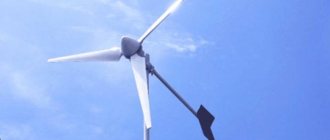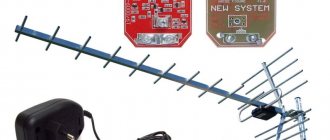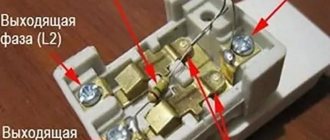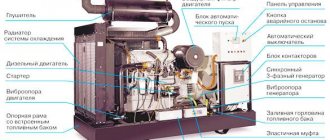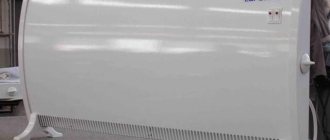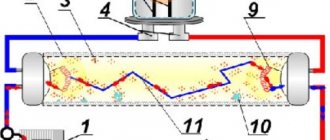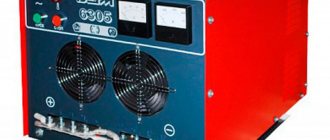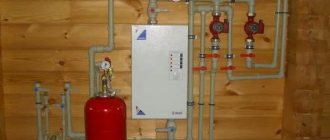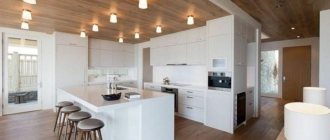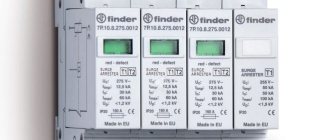With the ever-increasing density and coverage of power transmission networks, the quality and stability are not getting better, and prices are only getting higher every season. One of the best alternative sources of electricity today is an autonomous wind generator for a private home. Let's look at what this device is, what parts it consists of, how it works, what pros and cons it has, what are the legal requirements for its installation, what types exist, and what are the rules for its selection, placement and installation.
Wind power generator for home Source usamodelkina.ru
Wind generator: device, principle of operation, pros and cons
If there are constant winds in the area where you live, purchasing and installing a wind generator is quite advisable. However, before purchasing it, you need to understand its structure, operating principle and main advantages and disadvantages. Let's look at these aspects in more detail.
Main components
The design of a wind generator is based on the conversion of the kinetic force of the wind load into mechanical energy, followed by its conversion into electricity. To implement the sequential actions of this transition chain, the device is equipped with the following main components:
- Bladed propeller. The number of blades can vary widely from model to model - from two and three to ten or more.
- Rotor. The turbine element that rotates under the action of the blades.
- Gearbox. Transmits and regulates the rotation speed from the rotor to the generator.
- Generator. Mechanical force is converted into electricity.
- Inverter is a current converter from AC to DC.
Composition of a wind generator Source odnastroyka.ru
- Accumulator battery. Stores electricity in case of shutdown and economical operation of the wind generator, as well as downtime in case of no wind.
- Protective housing. Protects equipment from various external factors.
- Aero components. Wings, tail - for better capture and adjustment of the propeller to the wind flow.
Note! Modern manufacturers produce wind home generators that do not require strong wind flow. They are able to function productively with a wind force of only 4 m/sec.
Operating principle
The mechanism of operation of the wind generator is directly related to the features of its design - a propeller and a shank are installed on the same axis with a counterweight point located at the point of attachment to the vertical mast. The action occurs according to the following algorithm:
- The propeller and tail mounted on the same axis capture wind flows and transmit them to the blades.
- As the blades begin to rotate, they transmit torque to the generator turbine.
- Rotation of the rotor leads to the formation of an inductive magnetic field and the generation of alternating electric current.
Wind generator on its own country plot Source moe-online.ru
- Then, passing through the inverter, the voltage changes the variable characteristics to constant ones.
- The current powers the battery, which in turn distributes energy to consumer power in the house.
Helpful information! A wind generator can play the role of both the main and additional source of electricity. In the first case, the core from the device powers some of the devices to save or replenish the power shortage of the main network and is used in case of emergency shutdown of the latter. In the second case, it can be an independent source or part of an autonomous system, including hydraulic turbines, solar panels, etc. equipment.
See also: Catalog of companies that specialize in engineering systems (heating, water supply, sewerage and others) and related work
Advantages and disadvantages
An autonomous wind power plant for a private home has the following number of advantages:
- The device operates using a virtually inexhaustible and renewable energy resource.
- Significant costs are associated only with purchase, delivery, installation and connection. Funds are practically spent on maintenance. Therefore, a windmill requires a one-time investment that quickly pays off in subsequent use.
Wind generator - power source for a private home Source ytimg.com
- The resulting type of energy and the technology used for this purpose are completely environmentally friendly.
- Generators are adapted to all climatic zones and are protected from negative weather factors.
- The equipment does not require settings, adjustments or modifications during operation.
The disadvantages of wind generators include:
- Dependence of productivity on the presence of wind.
- During operation, the equipment creates electromagnetic interference, which can negatively affect TV, radio, Internet and communications.
- During extreme weather events, there is a risk of damage to equipment.
- Mandatory grounding is required to protect the device and the structure or building on which it is installed from lightning strikes.
- Incorrect installation, violation of instructions, or operation of a faulty unit can lead to noise.
Advice! To determine whether it will be profitable to install a wind power station to generate current, it is necessary to take into account a number of factors - the power supply option involving the device, the variety of available models, their characteristics, performance and cost.
Wind generator in the courtyard of the house Source pechiexpert.ru
Geography of application
Wind energy is most widespread on the west coast of the Atlantic, in particular in Germany. There are the best conditions - smooth and strong winds, optimal climatic indicators. But the main reason for the widespread use of wind power plants in this region was the lack of opportunities for the construction of hydroelectric power plants, which forced the governments of the countries in this region to use available methods of generating electricity. At the same time, there are installations in the Baltic region, Denmark, and Holland.
Russia is still lagging behind in this matter; over the past decade, barely a dozen wind farms have been commissioned. The reason for this lag lies in the great development of hydropower and the lack of proper conditions for the operation of industrial wind power stations. However, there is an increase in the production of small installations capable of providing energy to individual estates.
Legal Requirements
In order for a wind generator installed on a private house or adjacent territory to be consistent with the legal framework, it must meet the following series of requirements:
- Power is not higher than 5 kW. Equipment with this indicator refers to household devices that do not require control by energy regulatory institutions.
- Absence of municipal-territorial and technical restrictions on the occupied area. Some private territories may be located inside specially protected, rare natural or other status objects, within which the placement of certain technical equipment is prohibited.
- Coordination with neighbors (interference, noise, falling shadow, etc.). All types of interference that arise from the installation can cause complaints not only from neighbors, but also from nearby enterprises and transmission centers.
- Mast height to meet local and federal requirements. The height of the mast usually does not exceed 15 meters, but there may be exceptions. Therefore, before constructing a tall structure, you need to make sure that it meets all the necessary requirements - no power lines, away from the airport landing line, etc.
Windmill on the facade of a private house Source more-el.com
- No disturbance to local or migratory species. Birds often get caught in the blades of power plants. Therefore, the choice of location for installing a mast with a propeller should exclude previously known flight paths.
Recommendation! To exclude all possible claims from neighbors or regulatory authorities, it is better to collect in advance all the necessary documents, technical passports and certificates confirming that a wind turbine for a private home is safe and harmless. In addition, it is better to install the factory model in full accordance with the parameters recommended in the technical documentation.
Operating principle
According to the diagram below, the operating principle of the wind generator can be described as follows:
- under the influence of air currents (No. 1 in the diagram), rotor “A” and blades “B” attached to it are set into rotational motion;
- the rotational movement (No. 2 in the diagram) of rotor “A” is transmitted to the drive axle “C” and gearbox “D” (gearbox);
- from the gearbox “D”, the rotational motion is transmitted to the electric generator “G”, in the windings of which electric current is generated.
Varieties
In order to choose the right wind generator, you must first take into account its technical parameters. Modern models differ in the following number of characteristics:
- The number of propeller blades. A large number of screw elements complicates the design. However, the more blades, the lower the wind speed needed to start the mechanism.
- Type of blade material. Models with rigid propellers are stronger and more durable, but also much more expensive than their sailing counterparts.
Multi-blade wind generator for your home Source ytimg.com
- The location of the rotation guide. Divided into vertical and horizontal. The former are stronger and more sensitive, the latter have better performance.
- Possibility of changing step characteristics. They differ in models with variable and constant pitch. Products with variable step parameters allow you to increase speed, and therefore productivity. However, they are more complex, bulky and expensive.
Good to know! Factory models widely available today are quite expensive. Therefore, those who want to install such an autonomous power plant often have the question of how to make a wind generator. Homemade analogues are often made from car generators connected according to a circuit with a similar 12-volt battery.
Average prices
The cost of wind generators depends on the design, power, country and manufacturer.
The cost of the models discussed above is:
- EnergyWind, depending on power (from 1.0 to 10.0 kW), ranges from 68,000.00 to 650,000.00 rubles, respectively.
- Exmork from Zonhan Windpower Co, Ltd (China), depending on the power (from 0.3 to 5.0 kW), ranges from 30,000.00 to 260,000.00 rubles, respectively.
- Bekar, depending on power (from 0.5 to 60.0 kW), ranges from 43,000.00 rubles.
Criterias of choice
When choosing a wind generator, in addition to technical characteristics, it is also necessary to correctly set the required power. It is set by such a parameter as the diameter of the rotor, which can be calculated using the following formula:
Egod = 1.64 * D2 * O3
Egod – total electricity consumed by appliances at home per year, kW,
D – rotor diameter, indicated in meters,
О – average annual wind speed, meter/second.
By substituting known parameters into this form, it is possible to calculate what diameter rotor a wind power plant for a home should be equipped with in a particular case.
Manufacturers
The domestic industry has established serial production of a wide range of household wind generators. Their parameters are shown in the table:
| Model | Manufacturer | Type | Power | Note |
| VG 0.25 | Vetro Svet, Russia | G | 250 W | — |
| VEU-3(4) | SKB Iskra, Russia | IN | 3 kW | 4-blade model |
| Series L | Wind power, Russia | IN | 0.8 – 10 kW | — |
| RKraft | Germany | G | 0.5 – 5 kW | — |
| Wind Generator M300 | China | IN | 100 – 270 W | 6-blade rotor with a diameter of 1 m, weight 11 kg, does not have a controller |
| Condor Home | EDS Group, Russia | G | 500 W | 3-blade fiberglass rotor Maximum wind speed 25 m/s Weight 56 kg |
Note: G – horizontal, V – vertical
Posting rules
When installing the device, the following requirements must be taken into account:
- There should be no structures, bushes, trees or other obstacles in the vicinity of the generator to obstruct the free passage of wind flows.
- To prevent noise and interference from work from having a negative impact on others, it is better to place windmills for the home at least 30 meters away from the home.
- To avoid weakening wind flows, it is better to install the mechanism 2-3 meters higher than surrounding obstacles, even if they are located at a distance of up to 200 meters.
False theories
The most common myths about wind energy:
- Windmills kill birds. It’s hard to deny that birds sometimes crash into the blades or mast of a wind turbine and die. But just as many birds are killed by electrical wires. According to statistics, most birds die due to cat attacks.
- The most common false theory is that the noise from a wind generator can negatively affect human health, including complications with the hearing organs.
- Not an environmentally friendly source, since the increase in the number of wind farms increases carbon dioxide emissions. Yes, but compared to coal or gas power plants, this figure is 50 times less.
- Unemployment. There is a belief that generating energy this way will eliminate jobs, but this myth is easy to dispel. Unemployment cannot arise in any developing sector, since wind energy always needs new personnel - researchers, developers.
False theories appear due to ignorance of the topic, but all of them are easy to refute, which has been done many times.
Installation Features
An industrially manufactured or home-made wind turbine must be installed in compliance with the following minimum requirements:
- It is better to select an installation location on a hill, away from obstacles, and place the device at a height of at least 10 meters from the ground surface.
- The mast must have a reliable base - preferably concrete.
- It is necessary to place a small canopy over the windmill to protect it from precipitation.
- If replacement, repair or maintenance is necessary, the folding design of the mast will allow easier access to the equipment.
On a note! When deciding how to make a windmill so that it is durable and easy to maintain, you need to pay attention to the number of phases generated by the device. Thus, three-phase models, compared to single-phase analogues, do not hum, do not vibrate and are characterized by a better service life.
Global wind distribution
To correctly calculate the installation location of a wind power plant, many factors must be taken into account. Regions with high potential are considered to be places where the average wind speed is about 9 m/s. Such places include Latin America, Greenland, western and northern parts of Europe, central Asia, and central North America.
Assessing wind resources is a complex process. Main factors to pay attention to:
- what winds prevail;
- relief and altitude of the area;
- the presence of reservoirs, vegetation, and various buildings.
Most of the land is not suitable for the location of such stations. The starting speed for generating electricity is 4 m/s. The optimal speed is about 10 m/s.
Briefly about the main thing
A wind generator for home is one of the best alternative sources of electricity. The principle of its operation is based on converting the kinetic energy of the wind into mechanical energy, and then, with the help of a rotor, into electrical energy. Among its main advantages are:
- Work using an inexhaustible source of energy – wind.
- Costs are associated only with purchase and installation; the equipment is durable and does not require special maintenance.
- Adaptability for any climate.
- An environmentally friendly type of energy resource.
Disadvantages include dependence on wind force, interference, and the possibility of destruction during extreme weather events. The installation of a wind generator must comply with legal requirements - power, height, restrictions, coordination with neighbors and absence of biological harm. Models differ in technical parameters - the number of blades, the type of their material, the direction of the axis of rotation and pitch variability. When choosing, you need to take into account the rotor diameter, which determines the power. Installation of the device must comply with the placement rules and practical recommendations.
How to choose a wind generator
In order to select a wind generator you must:
- Calculate the installed power of electrical appliances that are planned to be connected to this energy source.
- Based on the obtained power values and the average annual wind speed in the region where the unit is installed, the power of the generator is determined. The power should be taken taking into account the safety factor, taking into account the increase in loads and so as not to overload the device during peak loads.
- The climate in the place where the device is installed should be taken into account, since precipitation negatively affects the performance of the generator. Take into account the climatic features of the place of residence.
- Determining the efficiency of an installation is one of the most important indicators.
- Find out the performance of the generator in relation to the noise produced during operation.
- Conduct a comparative analysis of various types of generators according to all characteristics and parameters.
- Read reviews from users of similar installations.
- Make an analysis of domestic and foreign manufacturers, study reviews of these enterprises.
Classification
The main criteria that determine the types of wind turbines are the following:
- The difference is in the number of blades. High-speed and low-blade devices have up to 4 blades, and 4 and higher belong to low-speed multi-blade devices. The fewer the number of blades, the higher the engine speed.
- Rated power value. Household - up to 15 kW, semi-industrial - from 15 to 100 kW, industrial - from 100 kW to 1 MW. The boundaries between the indicators are quite arbitrary, so settings are applied where it is really necessary.
- Axis direction. Two types are used in the designs. In the first case, this is a horizontal axis located perpendicular to the air movement, reminiscent of a regular weather vane. Such generators are characterized by higher efficiency and reasonable cost. The second option is a vertical axis, which makes the generator design more compact. It does not depend on the direction of the wind, and its blades are made in the form of turbines. The axle load is significantly reduced, therefore the power of such installations is much less. Some power plants simultaneously use several generators with different axes, connected in a network, which makes it possible to obtain high power in a relatively small area.
Comments:
Uncle Vova
I assembled a vertical windmill from an oil drum, it worked until winter. The bearings in the generator are covered because... In the spring, it only produced creaking and grinding noises, but no electricity. You need very good bearings.
Evgen
I’ve been hooked up to a regular Zhiguli generator and it’s been working fine for three years now. It illuminates the street, and in the summer I connect a mole repeller to it. It seems to me that the problem is not in the bearings, but in the tightness.
Bogdan
Evgen, of course, the problem is tightness, but if you install seals that will not allow moisture to pass into the bearing, the efficiency of the entire structure will decrease. So I’m thinking, what should I do? Should I leave everything open or seal it as much as possible?
Igor
People, what are you talking about? Do you want to protect your car generator with something else? Yes, it is designed to work in such extreme conditions that a windmill (even one made from a barrel) is a vacation for it! There is always water, dirt and snow under the hood and the temperatures are the most extreme. The fact that Uncle Vova’s bearings broke on his auto-generator means that they had been broken for a long time, and were waiting for the “right moment” to announce it.
Vladimir
Bearings must be taken from 18 GPP, or from France, Sweden. I think SKF bearings with original lubrication (hub) have been working for 12 years, and there is zero noise.
Madi
The most advanced vertical-axis wind generator https://www.facebook.com/madiz.zhakypov/posts/10154799110278007
Virtual Private Server
That is, it turns out that people are simply being deceived by saying that vertical wind generators are more efficient in low winds. There are also Daria rotors, they are faster and larger than KIEV, but they have problems with starting in low winds and uneven thrust, and their calculation is very complicated.
Michael
One thing is clear: the windmill must be installed in “batteries” of three to six... pieces. Then it will make sense. At least heat the water.
Leave a comment Cancel reply
Related Posts
How to choose a solar panel - overview of important parameters
Real Application of Thin Film Solar Cells
Is it profitable to buy a set of solar panels for a summer residence?
Fuel-free generator - a way to make money on illiteracy
Wind power in the world
Wind energy is an alternative source of energy and many countries use it. The study of wind energy has become a popular and rapidly growing field in recent decades. Last year, 93 GW of new installations were installed.
The leading countries where much attention is paid to this are the USA, Canada, Great Britain, Denmark, Germany, and China.
It should be noted! Wind energy is being used by people more and more often, for example, the share of energy received in Denmark is 28% of the entire energy industry, in China it is 36%.
The outlook for wind energy development remains positive, and in the near future the number of countries that will introduce an alternative method of energy production will only increase.
Vertical axis wind turbines
The design of the blades of rotary wind power plants is varied.
This is due to the search for the most rational blade shape that uses maximum wind energy.
Apart from the shape of the blades and the orientation of the rotor shaft, vertical windmills are not much different from horizontal ones. Until recently, they were efficient, transferring 35% of wind energy to the consumer.
Electricity
Electricity is a unique resource.
It can be produced in any quantity, it is inexhaustible and is not based on fossil elements. Such properties make electricity very in demand, widespread and popular. There is also a downside - producing electricity requires fairly powerful equipment that requires maintenance, repairs and other work that can only be performed by qualified people. Electric mains, an extensive network of which covers the entire country, lead only to densely populated areas, bypassing remote regions. This is understandable, since the costs of installing power lines are very high, so only the largest points are provided with electricity first.
Wind power in Russia
At the moment, Russia uses such a resource as wind quite poorly. The government does not provide enough subsidies for the research and purchase of structures.
The largest wind power plant in Russia was launched in 2020 in the Stavropol Territory. The operating power of each of the 84 installations is 2.5 MW.
The share of wind energy in the country's overall energy system is insignificant, and most likely will not change in the near future. Over the past year, wind turbines generated less than 1% of the total energy consumed. This is due to the fact that other methods of energy production have been developed in the country. However, we must remember that wind energy is inexhaustible and we cannot refuse an alternative and fast-growing industry.
Methods for autonomous generation of electricity and their consequences
The problem of lack of electricity can be solved in different ways. Diesel and gasoline generators are common, and sometimes there are mini-hydroelectric power plants that can provide energy to a small village. All these methods have a certain drawback - they negatively affect the surrounding nature. Emissions from engines of gasoline or diesel generators have a detrimental effect on the atmosphere and contain vapors of lead and other harmful chemical compounds.
Dams formed to create mini-hydroelectric power stations create artificial reservoirs that disrupt the natural balance of natural processes in the region, change the hydrodynamic regime of groundwater aquifers, and the volume of supply of rivers located downstream. All these impacts trigger processes that destroy the country’s natural resources. The most dangerous thing about them is their invisibility and gradual action. Everything happens very slowly, gradually, until one day it turns out that irreversible changes have occurred that completely change the state of the ecology in the region.
Wind turbines with horizontal axis
The design of the installation depends on the generation power. A simple wind generator consists of the following components.
More complex installations are equipped with additional components to control the rotation speed of the generator shaft and minimize the risk of accidents:
- a brake mechanism to stabilize the shaft rotation speed at variable wind speeds;
- an intermediate gearbox located on the mast, between the pulley shaft and the rotor shaft;
- an intermediate gearbox with a bevel gear, in the case of a ground-based generator - this design will prevent breakdown of the electric generator in the event of a hurricane.
For small installations, the dominant factor ensuring reliability is simplicity of design.
